 If you look up Bing Crosby in Wikipedia, the first thing you’ll notice is his real name was Harry. The second thing you’ll read, though, is that he is considered the first “multimedia star.” In 1948, half of the recorded music played on the air was by Bing Crosby. He also was a major motion picture star and a top-selling recording artist. However, while you might remember Bing for his songs like White Christmas, or for his orange juice commercials, or for accusations of poor treatment from his children, you probably don’t associate him with the use of magnetic tape.
If you look up Bing Crosby in Wikipedia, the first thing you’ll notice is his real name was Harry. The second thing you’ll read, though, is that he is considered the first “multimedia star.” In 1948, half of the recorded music played on the air was by Bing Crosby. He also was a major motion picture star and a top-selling recording artist. However, while you might remember Bing for his songs like White Christmas, or for his orange juice commercials, or for accusations of poor treatment from his children, you probably don’t associate him with the use of magnetic tape.
In a way, Bing might have been akin to the Steve Jobs of the day. He didn’t power the technology for tape recording. But he did see the value of it, invested in it, and brought it to the market. Turns out Bing was quite the businessman. Want to know why he did all those Minute Maid commercials? He was a large shareholder in the company and was the west coast distributor for their products. He also owned part of the Pittsburgh Pirate baseball team and other businesses.
So how did Bing become instrumental in introducing magnetic tape recording? Because he was tired of doing live shows. You see, in 1936, Crosby became the host of a radio variety show, The Kraft Music Hall. This very popular program was live. That means you have to show up on time. If you go off on a tangent, you’ll run out of time. And if you make a mistake, there is no editing. Oh and one other thing. You have to do a nationwide live show twice: once for the east coast and another for the west. This was cutting into Bing’s “family time” which, as far as we can ascertain was a code phrase for golf.
The Summer of Discontent
By 1945, Crosby was discontented and wanted to prerecord the shows using electrical transcription. If that term is unfamiliar, it is a late 1920s technology for pressing records for use in broadcasting. Although they look like large conventional records, they have a higher quality. Just about all the old radio programs you hear were originally recorded using this system. The infamous “Oh the humanity!” reporting by Herbert Morrison of WLS while watching the Hindenburg disaster was captured by electrical transcription — and subsequently replayed at the wrong speed for decades.
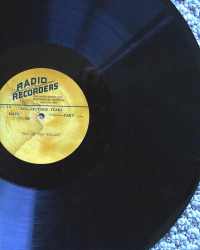 A normal LP record is about 12 inches, but most of the older electronic transcription discs (or ETs) were 16 inches in diameter. In the 1960s, though, ETs looked almost exactly like a regular LP record. Even the big disks held about 15 minutes of audio on each side.
A normal LP record is about 12 inches, but most of the older electronic transcription discs (or ETs) were 16 inches in diameter. In the 1960s, though, ETs looked almost exactly like a regular LP record. Even the big disks held about 15 minutes of audio on each side.
The recordings were either cut into wax and then electroplated to produce a master that could produce a shellac or vinyl record or — a faster process — by indenting directly into an aluminum, steel, glass, or fiber disk coated with something (nitrocellulose, wax, or a few other compounds) soft enough to indent. These could be played back at once. By the way, if you ever run into any ETs and want to preserve them, there’s a lot of information about that over at the Audio Archive.
https://www.youtube.com/watch?v=vNSE8HqYfmw
This was great in a way, but cumbersome and the quality wasn’t very good. Perhaps the worst thing, though, was that editing was very difficult or impossible.
NBC Doesn’t Like It
The Kraft Music Hall started airing on the NBC Red network at a time when NBC ruled the airwaves. During the 1945-1946 season, Crosby refused to do the show live and NBC refused to accept it recorded, so Bing walked. NBC sued Crosby to finish out the season, but after that, they were done.
This might not have been a great choice for NBC since the government had forced them to sell off the Blue network back in 1941. Up and coming networks like ABC needed a way to capture market share and Bing was extremely popular. For the 1946-1947 season, ABC wanted Bing to do the Philco Radio Time program. Bing wanted to record it and the network agreed, but only if the quality of the show was equal to a live broadcast.
The show took up two ETs and the quality just wasn’t there. Editing was very painful, as well, requiring a disk to be played back to another recording disk. That also led to reduced quality. As ratings fell, ABC pushed to go back to the live format.
German Engineering
Jack Mullin — like a lot of Americans in those days — had served in the Army in Europe during World War II. Before he came home, he shipped two AEG/ IG Farben Magnetophon recorders home in pieces over the course of several months. Tape and wire recorders were not unheard of at the time. However, the Magnetophon was a very high-quality machine used for radio broadcasting in Germany, including allowing Hitler to broadcast from one town while actually being in another.
The machines were the first to use AC tape bias to practically eliminate tape hiss. Mullin was shrewd enough or lucky enough to realize that the Magnetophon was far superior. He and friend William Palmer rebuilt the recorders to use US parts and added a few other improvements.
The resulting recorder — which looked an awful lot like what we would call a reel-to-reel recorder — was a game changer. The sound quality was excellent and magnetic tape could be easily cut and spliced using a razor and adhesive tape.
You might wonder how good the recording quality could be. After all, we are used to turning our nose up at anything that isn’t CD quality or even higher today. But remember that these recordings were destined to play back over monoaural AM radio stations replete with atmospheric noise, fading, and all the other issues with AM radios. While the quality wasn’t up to our modern standards, it was plenty for its time.
To Scale
Everyone who saw the recorders was impressed but disappointed to learn there were only two machines and 50 reels of tape. Among the people who saw it was Frank Healey who was involved in the Bing Crosby show’s production. That led to Crosby’s producer, Murdo McKenzie, to find out more about the machines. After visiting Mullin and Palmer in San Francisco, they brought in Bing himself.
Bing was impressed and they wanted a test recording of the first show of the 1947-1948 season. But there was a concern about the limited number of recordings and tapes. 3M had been making tapes with paper and had evolved into using plastic backings. However, their current tapes could not record the strong magnetic field used by the Magnetophon.
Meanwhile, ABC was interested in another tape technology also acquired from Germany, but using inferior recorders. There was a showdown, recording the same show on both recorders and an ET. The ABC-backed recorder was noisy and used inferior tape. But the Magnetophon sounded great.
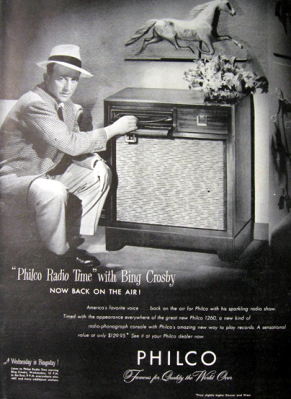 On October 1st, 1947, the first radio show to be recorded directly to magnetic tape hit the airwaves. Because the tape was in limited supply and had been spliced many times, it was prone to breakage. So after editing, the tape would still be pressed onto an ET for actual broadcast. This was still an improvement both because editing was much easier, and because the ET was only pressed once so its quality was not impaired by multiple editing passes. If you compare the quality of the recording from 1947 with the first one, you can hear a big difference.
On October 1st, 1947, the first radio show to be recorded directly to magnetic tape hit the airwaves. Because the tape was in limited supply and had been spliced many times, it was prone to breakage. So after editing, the tape would still be pressed onto an ET for actual broadcast. This was still an improvement both because editing was much easier, and because the ET was only pressed once so its quality was not impaired by multiple editing passes. If you compare the quality of the recording from 1947 with the first one, you can hear a big difference.
Mullin would go on to work with Ampex — a company that had made motors and generators during the war — and 3M to make a broadcast-quality recorder and matching tape. They had everything ready to go, but there was one snag: Ampex was out of money.
Daddy Warbucks
Bing really wanted those tape machines. Alexander Poniatoff of Ampex received an envelope from Bing with no letter enclosed. But there was a check for $50,000. In 1948 that would be about like getting a check for over a half million today.
Bing’s company not only distributed orange juice but became the west coast distributor for both Ampex recorders and 3M tapes. Mullin went on to become Crosby’s company’s chief engineer.
Eventually, Ampex would even produce “portable” units, each consisting of two large, two-person, crates that could travel with the Bing Crosby program on the road.
Even More
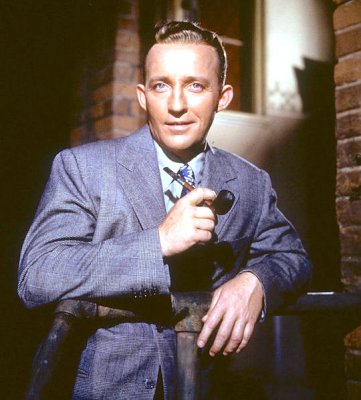 If you think Crosby just ponied up money, you’d be wrong. He experimented with different ways to use the new technology and understood what it could mean to the entertainment business. Later, he’d even have a hand in fostering video recording in the 1950s. In the end, though, Ampex produced a better recorder than Bing’s engineers and — once again — received another $50,000 check from Bing for the first few off the assembly line.
If you think Crosby just ponied up money, you’d be wrong. He experimented with different ways to use the new technology and understood what it could mean to the entertainment business. Later, he’d even have a hand in fostering video recording in the 1950s. In the end, though, Ampex produced a better recorder than Bing’s engineers and — once again — received another $50,000 check from Bing for the first few off the assembly line.
This really isn’t the story of the invention of the tape recorder. Mullins didn’t invent it and neither did Bing Crosby. You could argue that radio pioneer Valdemar Poulsen demonstrated that with the telegraphone, which he patented in 1898! Without electronic amplification, though, recording on wire, disks, and tape didn’t catch on. His recording of Emperor Franz Josef of Austria in 1900 is thought to be the oldest surviving magnetic audio recording, but we’re guessing that you know more of the lyrics to White Christmas.
It reminds us that great technology isn’t always sufficient. Sometimes the winner is the person who has the vision to see how a technology can be transformative.
Photo credits: Magnetophon by George Shuklin CC 1.0

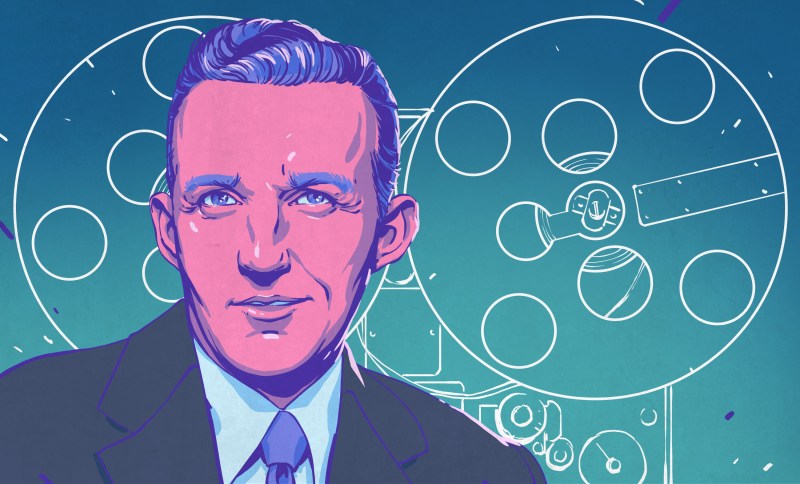
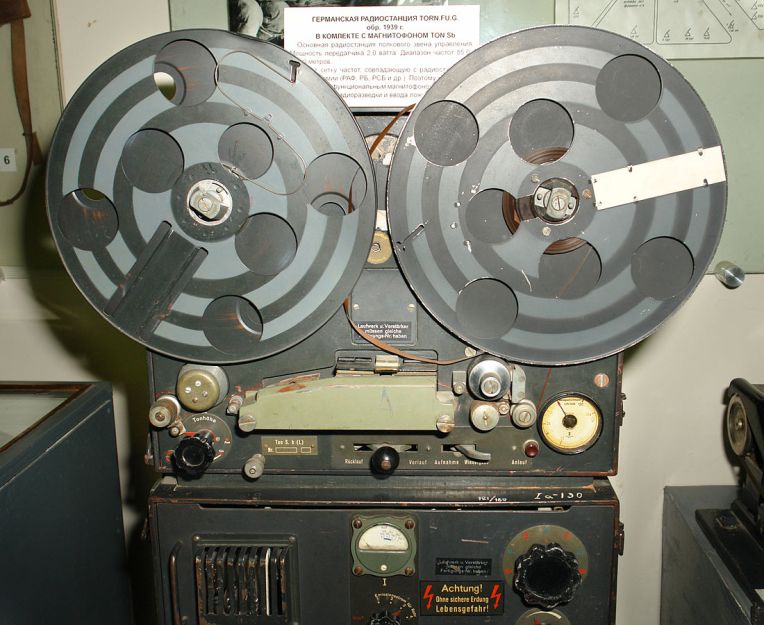
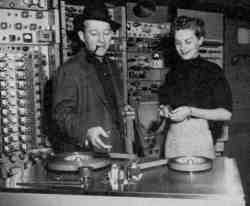
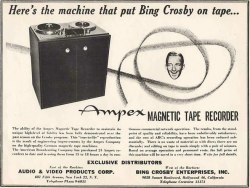













He was also Denise Crosby’s grandfather (Tasha Yar from STTNG)
TIL. Talk about squandering a head start in the entertainment industry (sorry, Tasha Yar fans).
I think she’s happy with the way things turned out. We met her on the last star trek cruise and she’s a riot.
What a great article. At first I was disappointed to notice that “recorded programming” had nothing to do with computer data of any kind. But the story somehow got me and when I read the part about Herbert Morrison played back at the wrong speed I was hooked. Learned something interesting about mr. Crosby and his drive for using this new technology and seeing its business potential.
Thanks for posting!
How do you electroplate wax?
I don’t know about this particular case, but usually, you spray it with graphite first.
For example: https://hackaday.com/2015/08/23/metal-3d-printing-with-your-printer/
There’s an instance of “Magentophon” up there, which sounds like a T-Mobile product.
Ha… maybe Uneedaphon…. oh wait, that’s Radio Shack.
B^)
Go and laugh all of you, but guess who invented the VTR? (Video Tape Recorder) The cameras were all made by General Sarnoff’s outfit, but they never bothered to work out how to record video. It turns out that the Ampex people did that. And it followed from the same ideas presented here. The majority of studio VTR hardware was made by them. And in fact I know of one middle school who had a full TV studio inside it, that rivaled the ones at the regular TV networks. Unfortunately however they lost the market for portable stuff to the Japanese, although a simple portable one is scene in a Perry Mason episode,
Although it is not know of it was one of the early Panasonic jobs, or an early Ampex portable.
They practically went broke trying to sell that thing to home markets, never mind getting a cheap(?!?) video camera for recording home entertaining.
Oh and at one point some of the best audio gear came from Germany, Grundig for example.
Hey why are we thanking Crosby when we should be thanking Hitle… Um, Thank you Bing Crosby. :)
https://youtu.be/pnsizkVjGm8
“However, while you might remember Bing for his songs like White Christmas, or for his orange juice commercials, or for accusations of poor treatment from his children. But you probably don’t associate him with the use of magnetic tape.”
Remove either “However, while” or “. But”
FYI,
A Paul Harvey “The Rest of the Story”, claimed that the era of the “crooners” (e.g. Crosby) was the result of the distortion caused by the carbon microphone. Many an aspiring singer duplicated the unique sound they heard on the radio.
That was the best read I’ve had on HAD all week. Thanks.
Nice article. Expect for using the line of poor treatment accusations from children.
One child Gary Crosby. Who admitted that he did the book for money and was drunk when he relayed to the ghostwriter. Gary was interviewed by Gary Giddins Crosby biographer in 1995 before he died and admitted it. The publisher juiced it to sell the books. Bing Crosby was strict but he always admitted that. All the kids refuted what Gary Crosby wrote in the book. Fake news even in Bing’s day@